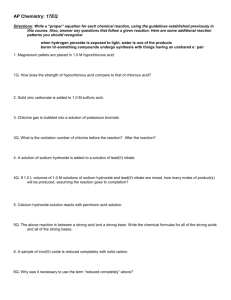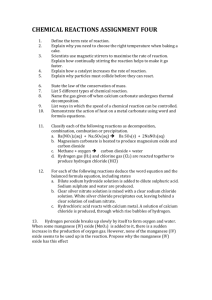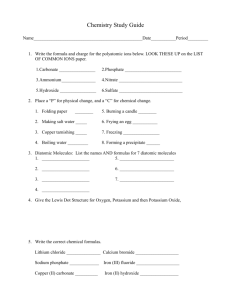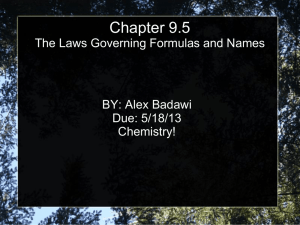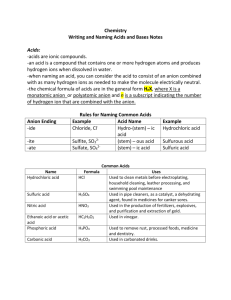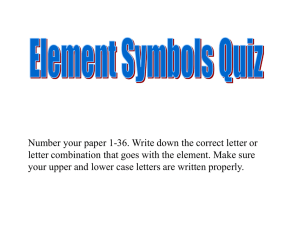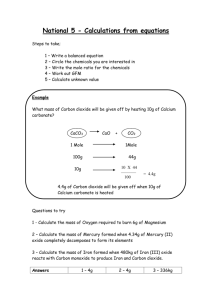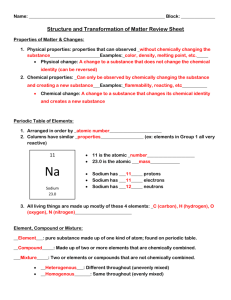Lesson 15 Making Compounds with Polyatomic Ions
advertisement
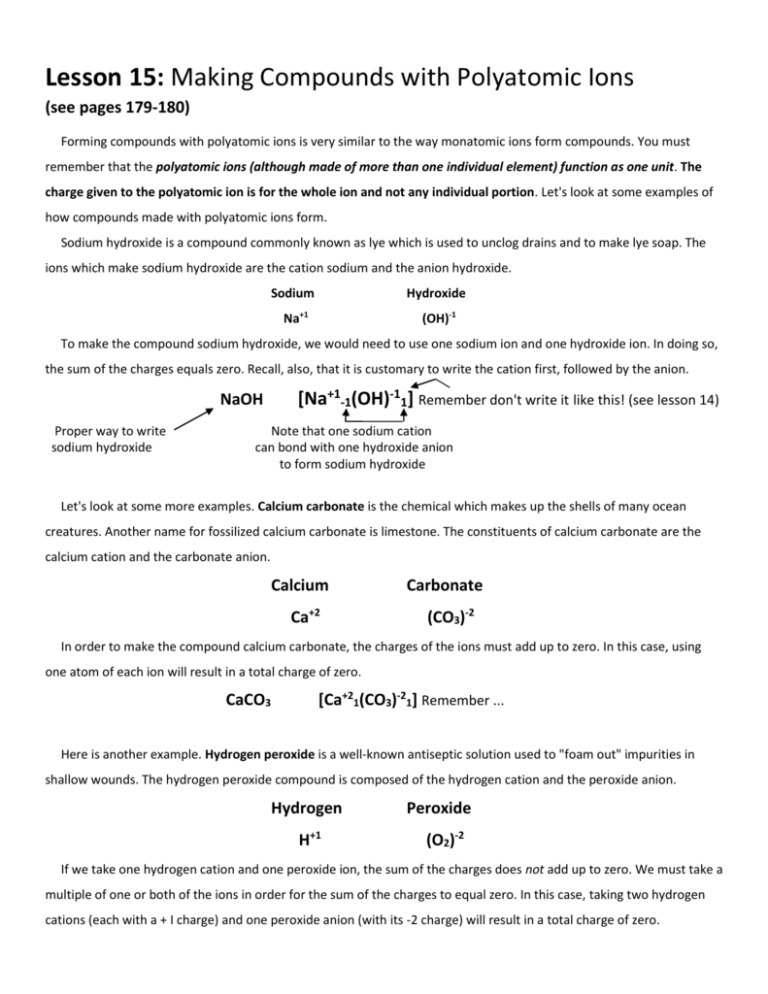
Lesson 15: Making Compounds with Polyatomic Ions (see pages 179-180) Forming compounds with polyatomic ions is very similar to the way monatomic ions form compounds. You must remember that the polyatomic ions (although made of more than one individual element) function as one unit. The charge given to the polyatomic ion is for the whole ion and not any individual portion. Let's look at some examples of how compounds made with polyatomic ions form. Sodium hydroxide is a compound commonly known as lye which is used to unclog drains and to make lye soap. The ions which make sodium hydroxide are the cation sodium and the anion hydroxide. Sodium Hydroxide Na+1 (OH)-1 To make the compound sodium hydroxide, we would need to use one sodium ion and one hydroxide ion. In doing so, the sum of the charges equals zero. Recall, also, that it is customary to write the cation first, followed by the anion. NaOH Proper way to write sodium hydroxide [Na+1-1(OH)-11] Remember don't write it like this! (see lesson 14) Note that one sodium cation can bond with one hydroxide anion to form sodium hydroxide Let's look at some more examples. Calcium carbonate is the chemical which makes up the shells of many ocean creatures. Another name for fossilized calcium carbonate is limestone. The constituents of calcium carbonate are the calcium cation and the carbonate anion. Calcium Ca+2 Carbonate (CO3)-2 In order to make the compound calcium carbonate, the charges of the ions must add up to zero. In this case, using one atom of each ion will result in a total charge of zero. CaCO3 [Ca+21(CO3)-21] Remember ... Here is another example. Hydrogen peroxide is a well-known antiseptic solution used to "foam out" impurities in shallow wounds. The hydrogen peroxide compound is composed of the hydrogen cation and the peroxide anion. Hydrogen H+1 Peroxide (O2)-2 If we take one hydrogen cation and one peroxide ion, the sum of the charges does not add up to zero. We must take a multiple of one or both of the ions in order for the sum of the charges to equal zero. In this case, taking two hydrogen cations (each with a + I charge) and one peroxide anion (with its -2 charge) will result in a total charge of zero. [H+12(O2)-21] Remember ... H 2 O2 Note that it takes two hydrogen cations for each peroxide anion to create the stable hydrogen peroxide compound. And here is a final example. The chemical formula for rust is iron (III) oxide. The iron (III) oxide compound is composed of the iron (III) cation and the oxide anion. Recall that ions with a Roman Numeral as part of their name, tell you the charge of the cation. In this case iron (III) is Fe+3. Iron (III) Fe+3 Oxide O-2 Forming this compound is a little more challenging. In order to get our charges to add to zero, we must take two iron (III) cations and three oxide cations. (2 times (+3) Fe2O3 plus 3 times ( -2) = 0) [Fe+32O-23] Remember ... Note that it takes two iron (III) cations along with three oxide anions to form rust! If you are given Fe2O3 and you are asked what is the charge (or oxidation state) of the iron cation, here is how you determine the charge on the iron cation: 1) The oxygen anion always has a charge of -2. So three oxygen anions have a charge of -6 [3 times (-2) = -6] 2) If the anion side (oxygen side) has a charge of -6, then the cation side (iron side) must have a charge of +6 for a neutral compound [-6 plus (+6) = 0] 3) Since the cation side (the iron side) has a charge of +6, each of the two iron cations must have a charge of +3. [2 times (+3) = +6] Write the chemical formula for each compound. Refer to the Master Ion List (Lesson 14) or your text if necessary. Compound Name Chemical Formula Compound Name I. Sodium chloride 21. Barium hydroxide 2. Potassium nitrate 22. Calcium nitrite 3. Lithium chloride 23. Cesium sulfate 4. Barium sulfite 24. Nickel nitrate 5. Calcium carbonate 25. Calcium oxide 6. Strontium oxide 26. Sodium bromide 7. Tin (IV) sulfate 27. Silver chromate 8. Hydrogen chlorate 28. Copper (II) fluoride 9. Potassium perchlorate 29. Potassium permanganate 10. Aluminum acetate 30. Lithium carbonate II. Magnesium sulfite 31. Nickel cyanide 12. Mercury (II) bromide 32. Lead (II) hypochlorite 13. Sodium dichromate 33. Zinc chlorite 14. Strontium iodide 34. Hydrogen peroxide 15. Ammonium dichromate 35. Copper (I) sulfite 16. Potassium chloride 36. Hydronium sulfide 17. Chromium perchlorate 37. Nickel phosphate 18. Calcium cyanide 38. Mercury (II) carbonate 19. Barium chlorite 39. Tin (IV) sulfate 20. Ammonium chloride 40. Potassium hydroxide Chemical Formula
